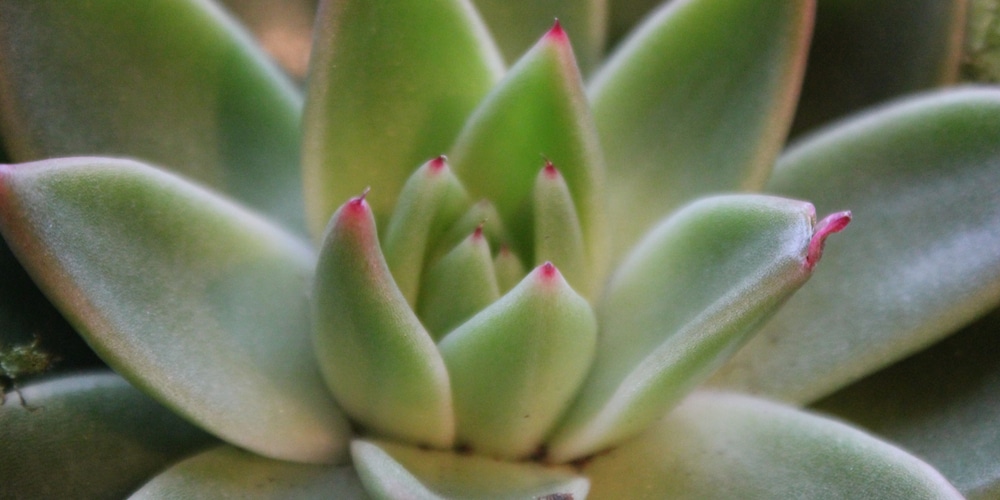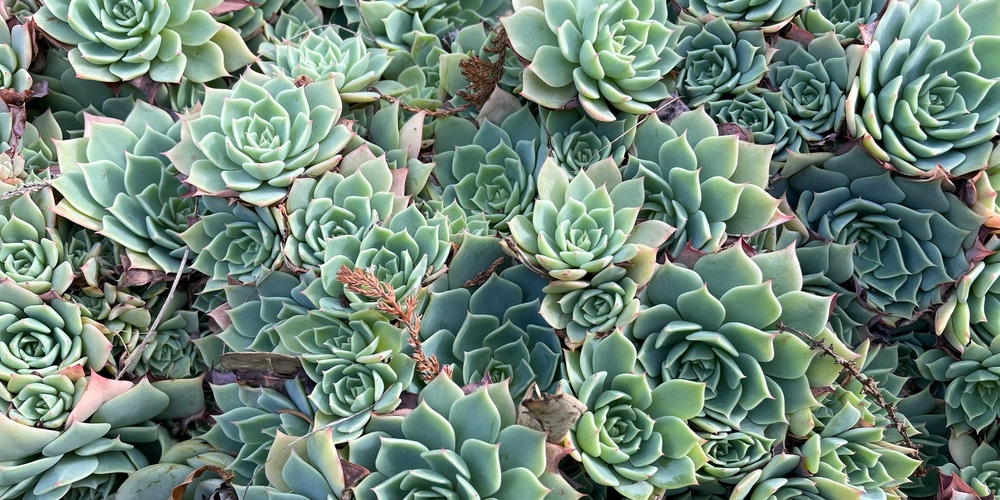Do you like succulents? If yes, you should learn more about Echeveria agavoides (also known as Wax Agave)! This plant, native to the arid and rocky areas of Mexico, belongs to the Crassulaceae family and produces thick rosettes with reddish tips and spiny edges.
You can find Echeveria agavoides in various cultivars, including Ebony, Lipstick, and Acquamarina. Keep reading this essential guide we put together for you to learn more about growing this succulent!

| Botanical Name | Echeveria agavoides |
| Common Name | Wax Echeveria, Wax Agave, Molded Wax Plant |
| Plant Type | Perennial |
| Flower Color | Slender flower stalks that produce pink and orange blossoms and grow up to 24 inches tall |
| Size When Mature | 3 to 5 inches tall and spread up to 6 inches. The plant’s rosettes can grow up to 6 inches in diameter. |
| Bloom Time | Spring |
| Sun Requirements | Full Sun |
| USDA Hardiness Zones | 9-12 |
| Soil PH Range | 6.0 to 7.0 |
| Soil Type | Well-draining and rich in essential nutrients |
| Water Needs | Low |
| Native Area | Mexico |
What you Need to Know About Echeveria Agavoides
Echeveria agavoides is a tiny succulent and popular addition to rock gardens. It also performs well as a house plant. Its versatility makes it the ideal choice even for beginner gardeners.
You can identify this succulent by looking at the shape and color of its leaves: they are triangular, thick, and will turn red when exposed to full sunlight.
Don’t forget that, as with most succulents, you will have to plant your Echeveria in adequate potting soil and avoid overwatering, which may cause severe issues to your green friend. But besides that, this variety of Echeveria isn’t particularly fussy. Plus, it is nontoxic to animals and humans, meaning you can safely add it as a houseplant without having to worry about your kids or pets munching on its leaves (of course, you should take measures to prevent them from doing so anyway!).
How to Care for Echeveria Agavoides
One of the best things about growing succulents is that they are low-maintenance plants that require little to no attention from your side.
Of course, to have a thriving Echeveria agavoides, you’ll have to meet its growing requirements. But don’t worry: here, we collected everything you need to know about growing your Echeveria Agavoides.
Light
Echeverias agavoides will perform better in full sun. However, we recommend you plant them where they can get protection from the afternoon light, which may burn their leaves.
If you need to overwinter it indoors, ensure you place it next to a south-facing window: your succulent will need as much light as possible. Also, don’t forget to rotate it frequently to ensure even growth.
Water and Soil Needs
Echeverias are succulents, meaning their moisture requirements are minimal. These plants are susceptible to soggy soils and will rot fast if you apply too much water.
To prevent this, you must plant your echeveria agavoides in well-draining soil. You can use a cactus potting mix to save yourself some additional work. Alternatively, create one by mixing perlite and sand to a “balanced” substrate.
These plants aren’t too picky about soil pH. However, they will perform better between 6.0 and 7.0. To avoid issues with watering, allow the soil to dry before adding extra moisture. Also, don’t forget to plant your echeverias in pots with suitable drainage holes.
Temperature Requirements
As you would expect, this Mexican native plant doesn’t like cold temperatures. It won’t survive winters if you don’t like it in a warm region. If you cannot offer your succulent USDA hardiness zones’ 9-12 climate, don’t worry! These plants perform excellently as houseplants. All you have to do is place them somewhere they will receive adequate lighting.
Fertilizer
Follow the tips we included in this essential guide, and you won’t need to fertilize your Echeveria. However, depending on the substrate, your plant might benefit from extra nutrients.
You can use a liquid (slow-release) fertilizer during the warmest months of the year to boost its growth. Of course, avoid overdoing it: you’ll cause more harm than good.
Common Diseases
One of the most common issues with Echeverias is overwatering. Besides that, pests will rarely attack your plants. Still, you may have to keep an eye on snails and slugs, which may attack your succulent if you grow it outdoors.
If you notice something off with your plant, ensure you take prompt action to minimize the spread of an infestation.
Echeveria Agavoides Propagation
You can propagate your Echeveria agavoides from cuttings or division. Once your plant finds its place, it will probably start expanding faster. While the process isn’t challenging, you’ll have to use a sharp knife and handle your plant carefully to avoid harming it.
Plant your cuttings (or divisions) in adequate soil and allow them to develop roots. And when they start growing out of the container, transplant them to a different pot!
Related Article: Echeveria Lola Care Guide

